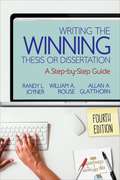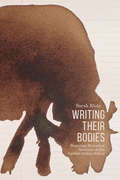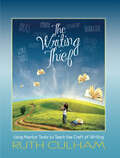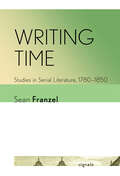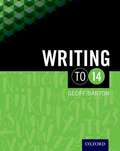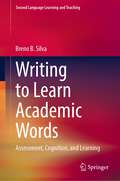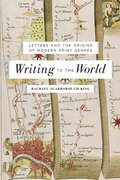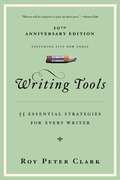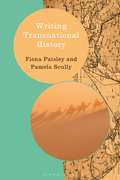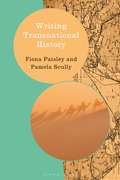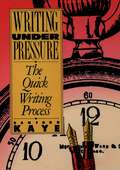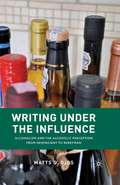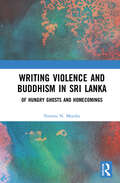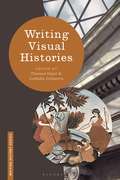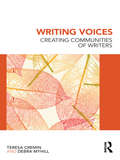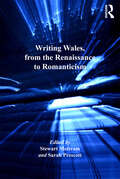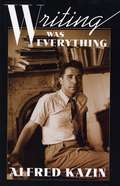- Table View
- List View
Writing the Winning Thesis or Dissertation: A Step-by-Step Guide (PDF)
by Randy Joyner William Rouse Allan GlatthornFrom research to defense, a masters thesis or doctoral dissertation is a major undertaking. Since 1998, this book has been the go-to resource for scholars seeking guidance at every phase of the process. This revised and updated fourth edition is the most comprehensive guide yet to researching, writing, and publishing a successful thesis or dissertation.
Writing Their Bodies: Restoring Rhetorical Relations at the Carlisle Indian School
by Sarah KlotzBetween 1879 and 1918, the Carlisle Indian Industrial School housed over 10,000 students and served as a prototype for boarding schools on and off reservations across the continent. Writing Their Bodies analyzes pedagogical philosophies and curricular materials through the perspective of written and visual student texts created during the school’s first three-year term. Using archival and decolonizing methodologies, Sarah Klotz historicizes remedial literacy education and proposes new ways of reading Indigenous rhetorics to expand what we know about the Native American textual tradition. This approach tracks the relationship between curriculum and resistance and enumerates an anti-assimilationist methodology for teachers and scholars of writing in contemporary classrooms. From the Carlisle archive emerges the concept of a rhetoric of relations, a set of Native American communicative practices that circulates in processes of intercultural interpretation and world-making. Klotz explores how embodied and material practices allowed Indigenous rhetors to maintain their cultural identities in the off-reservation boarding school system and critiques the settler fantasy of benevolence that propels assimilationist models of English education. Writing Their Bodies moves beyond language and literacy education where educators standardize and limit their students’ means of communication and describes the extraordinary expressive repositories that Indigenous rhetors draw upon to survive, persist, and build futures in colonial institutions of education.
Writing Thief: Using Mentor Texts to Teach the Craft of Writing
by Ruth CulhamMediocre writers borrow. Great writers steal. --T.S. EliotWriting thieves read widely, dive deeply into texts, and steal bits and pieces from great texts as models for their own writing. Author Ruth Culham admits to being a writing thief'sand she wants you and your students to become writing thieves, too! In The Writing Thief: Using Mentor Texts to Teach the Craft of Writing, Culham demonstrates a major part of good writing instruction is finding the right mentor texts to share with students. Within this book, you'll discover more than 90 excellent mentor texts, along with straight-forward activities that incorporate the traits of writing across informational, narrative, and argument modes. Chapters also include brief essays from beloved writing thieves such as Lester Laminack, David L. Harrison, Lisa Yee, Nicola Davies, Ralph Fletcher, Toni Buzzeo, Lola Schaefer, and Kate Messner, detailing the reading that has influenced their own writing. Culham's renowned easy-going style and friendly tone make this a book you'll turn to again and again as you coach your students to reach their full potential as deep, thoughtful readers and great writers. There's a writing thief in each of us when we learn how to read with a writer's eye!
Writing Thief: Using Mentor Texts to Teach the Craft of Writing
by Ruth CulhamMediocre writers borrow. Great writers steal. --T.S. EliotWriting thieves read widely, dive deeply into texts, and steal bits and pieces from great texts as models for their own writing. Author Ruth Culham admits to being a writing thief'sand she wants you and your students to become writing thieves, too! In The Writing Thief: Using Mentor Texts to Teach the Craft of Writing, Culham demonstrates a major part of good writing instruction is finding the right mentor texts to share with students. Within this book, you'll discover more than 90 excellent mentor texts, along with straight-forward activities that incorporate the traits of writing across informational, narrative, and argument modes. Chapters also include brief essays from beloved writing thieves such as Lester Laminack, David L. Harrison, Lisa Yee, Nicola Davies, Ralph Fletcher, Toni Buzzeo, Lola Schaefer, and Kate Messner, detailing the reading that has influenced their own writing. Culham's renowned easy-going style and friendly tone make this a book you'll turn to again and again as you coach your students to reach their full potential as deep, thoughtful readers and great writers. There's a writing thief in each of us when we learn how to read with a writer's eye!
Writing Time: Studies in Serial Literature, 1780–1850 (Signale: Modern German Letters, Cultures, and Thought)
by Sean FranzelWriting Time shows how serial literature based in journals and anthologies shaped the awareness of time at a transformative moment in the European literary and political landscapes. Sean Franzel explores how German-speaking authors and editors "write time" both by writing about time and by mapping time itself through specific literary formats.Through case studies of such writers as F. J. Bertuch, K. A. Böttinger, J. W. Goethe, Ludwig Börne, and Heinrich Heine, Franzel analyzes how serial writing predicated on open-ended continuation becomes a privileged mode of social commentary and literary entertainment and provides readers with an ongoing "history" of the present, or Zeitgeschichte. Drawing from media theory and periodical studies as well as from Reinhart Koselleck's work on processes of temporalization and "untimely" models of historical time, Writing Time presents "smaller" literary forms—the urban tableau, cultural reportage, and caricature—as new ways of imagining temporal unfolding, recentering periodicals and other serial forms at the heart of nineteenth-century print culture.
Writing To 14 (PDF)
by Geoff BartonWritten by trusted author Geoff Barton, this new edition of a classroom favourite has been completely rewritten to support the latest grade 6-8 requirements. The book offers skills-based writing support, with a variety of engaging tasks for students of all abilities. Stand alone activities andresources can be easily built into existing lesson plans or serve as handy cover lessons.
Writing to Learn Academic Words: Assessment, Cognition, and Learning (Second Language Learning and Teaching)
by Breno B. SilvaThis book highlights the importance of English academic vocabulary for success at university and explores written tasks as effective pedagogical tools to promote the acquisition of academic words. The book reviews germane and recent SLA, psycholinguistic, corpus linguistics, and L2 writing research to underscore the challenges associated with the learning of academic words. Then, it reports on three empirical studies conducted in the Polish context. The first study develops a reliable tool to assess the knowledge of academic vocabulary of undergraduate learners. The second and third studies investigate the learning of academic words after the writing of sentences and argumentative essays, and discuss the role of cognition as a mediator of such learning. The book also provides an accessible introduction to linear mixed-effect models, a powerful, reliable, and flexible statistical technique that has been gaining popularity among SLA and psycholinguistics researchers.
Writing to the World: Letters and the Origins of Modern Print Genres
by Rachael Scarborough KingIn Writing to the World, Rachael Scarborough King examines the shift from manuscript to print media culture in the long eighteenth century. She introduces the concept of the "bridge genre," which enables such change by transferring existing textual conventions to emerging modes of composition and circulation. She draws on this concept to reveal how four crucial genres that emerged during this time;¢;‚¬;€?the newspaper, the periodical, the novel, and the biography;¢;‚¬;€?were united by their reliance on letters to accustom readers to these new forms of print media.King explains that as newspapers, scientific journals, book reviews, and other new genres began to circulate widely, much of their form and content was borrowed from letters, allowing for easier access to these unfamiliar modes of printing and reading texts. Arguing that bridge genres encouraged people to see themselves as connected by networks of communication;¢;‚¬;€?as members of what they called "the world" of writing;¢;‚¬;€?King combines techniques of genre theory with archival research and literary interpretation, analyzing canonical works such as Addison and Steele;€™s Spectator, Samuel Johnson;€™s Lives of the Poets, and Jane Austen;€™s Northanger Abbey alongside anonymous periodicals and the letters of middle-class housewives. This original and groundbreaking work in media and literary history offers a model for the process of genre formation. Ultimately, Writing to the World is a sophisticated look at the intersection of print and the public sphere.
Writing to the World: Letters and the Origins of Modern Print Genres
by Rachael Scarborough KingIn Writing to the World, Rachael Scarborough King examines the shift from manuscript to print media culture in the long eighteenth century. She introduces the concept of the "bridge genre," which enables such change by transferring existing textual conventions to emerging modes of composition and circulation. She draws on this concept to reveal how four crucial genres that emerged during this time;¢;‚¬;€?the newspaper, the periodical, the novel, and the biography;¢;‚¬;€?were united by their reliance on letters to accustom readers to these new forms of print media.King explains that as newspapers, scientific journals, book reviews, and other new genres began to circulate widely, much of their form and content was borrowed from letters, allowing for easier access to these unfamiliar modes of printing and reading texts. Arguing that bridge genres encouraged people to see themselves as connected by networks of communication;¢;‚¬;€?as members of what they called "the world" of writing;¢;‚¬;€?King combines techniques of genre theory with archival research and literary interpretation, analyzing canonical works such as Addison and Steele;€™s Spectator, Samuel Johnson;€™s Lives of the Poets, and Jane Austen;€™s Northanger Abbey alongside anonymous periodicals and the letters of middle-class housewives. This original and groundbreaking work in media and literary history offers a model for the process of genre formation. Ultimately, Writing to the World is a sophisticated look at the intersection of print and the public sphere.
Writing Tools: 55 Essential Strategies for Every Writer
by Roy Peter ClarkA special 10th anniversary edition of Roy Peter Clark's bestselling guide to writing, featuring five bonus tools. Ten years ago, Roy Peter Clark, America's most influential writing teacher, whittled down almost thirty years of experience in journalism, writing, and teaching into a series of fifty short essays on different aspects of writing. In the past decade, Writing Tools has become a classic guidebook for novices and experts alike and remains one of the best loved books on writing available. Organized into four sections, "Nuts and Bolts," "Special Effects," "Blueprints for Stories," and "Useful Habits," Writing Tools is infused with more than 200 examples from journalism and literature. This new edition includes five brand new, never-before-shared tools. Accessible, entertaining, inspiring, and above all, useful for every type of writer, from high school student to novelist, Writing Tools is essential reading.
Writing Transnational History (Writing History)
by Fiona Paisley Pamela ScullyOver the past two decades, transnational history has become an established term describing approaches to the writing of world or global history that emphasise movement, dynamism and diversity. This book investigates the emergence of the 'transnational' as an approach, its limits, and parameters. It focuses particular attention on the contributions of postcolonial and feminist studies in reformulating transnational historiography as a move beyond the national to one focusing on oceans, the movement of people, and the contributions of the margins. It ends with a consideration of developing approaches such as translocalism. The book considers the new kinds of history that need to be written now that the transnational perspective has become widespread. Providing an accessible and engaging chronology of the field, it will be key reading for students of historiography and world history.
Writing Transnational History (Writing History)
by Fiona Paisley Pamela ScullyOver the past two decades, transnational history has become an established term describing approaches to the writing of world or global history that emphasise movement, dynamism and diversity. This book investigates the emergence of the 'transnational' as an approach, its limits, and parameters. It focuses particular attention on the contributions of postcolonial and feminist studies in reformulating transnational historiography as a move beyond the national to one focusing on oceans, the movement of people, and the contributions of the margins. It ends with a consideration of developing approaches such as translocalism. The book considers the new kinds of history that need to be written now that the transnational perspective has become widespread. Providing an accessible and engaging chronology of the field, it will be key reading for students of historiography and world history.
Writing Under Pressure: The Quick Writing Process
by Sanford KayeMost writing is done under pressure. An executive has to produce a three-page position paper by tomorrow at nine. A department head suddenly has to write a one-page action memo by noon. A graduate student has a twenty-page research paper due in a week. Yet, while most students and professionals write under pressure--with limited time, limited space, and a supervisor or instructor to please--few approach the task systematically. In Writing Under Pressure, Sanford Kaye, a renowned expert on the subject, presents a system he calls the Quick Writing Process (QWP) that focuses on real-world writing tasks and demonstrates how to produce the clearest, most honest, most powerful work possible under the constraints of time and space. A writing instructor with twenty-five years' experience teaching students and professionals in business and government, Kaye tells writers how to budget their time and how to use this time efficiently. Exploring particular writing situations in which QWP can be applied to make the most of what the writer knows, Kaye discusses the process of taking exams, focusing on how instructors select questions and evaluate essays. He also considers writing in business and government, featuring an insightful analysis of a memo written by Colonel Oliver North. This memo highlights one of the most important issues writers in business and government face: whether to write the truth as they see it or simply what their bosses want to hear. Presenting a wealth of such examples, Kaye reveals how to break through stifling organizational codes in order to write memos and position papers that count. While most guides to writing ignore the constraints of time and space, Writing Under Pressure tackles these problems head on, making it an essential reference for students, business professionals, government officials, or anyone else faced with a difficult writing assignment that has to be done now.
Writing Under Pressure: The Quick Writing Process
by Sanford KayeMost writing is done under pressure. An executive has to produce a three-page position paper by tomorrow at nine. A department head suddenly has to write a one-page action memo by noon. A graduate student has a twenty-page research paper due in a week. Yet, while most students and professionals write under pressure--with limited time, limited space, and a supervisor or instructor to please--few approach the task systematically. In Writing Under Pressure, Sanford Kaye, a renowned expert on the subject, presents a system he calls the Quick Writing Process (QWP) that focuses on real-world writing tasks and demonstrates how to produce the clearest, most honest, most powerful work possible under the constraints of time and space. A writing instructor with twenty-five years' experience teaching students and professionals in business and government, Kaye tells writers how to budget their time and how to use this time efficiently. Exploring particular writing situations in which QWP can be applied to make the most of what the writer knows, Kaye discusses the process of taking exams, focusing on how instructors select questions and evaluate essays. He also considers writing in business and government, featuring an insightful analysis of a memo written by Colonel Oliver North. This memo highlights one of the most important issues writers in business and government face: whether to write the truth as they see it or simply what their bosses want to hear. Presenting a wealth of such examples, Kaye reveals how to break through stifling organizational codes in order to write memos and position papers that count. While most guides to writing ignore the constraints of time and space, Writing Under Pressure tackles these problems head on, making it an essential reference for students, business professionals, government officials, or anyone else faced with a difficult writing assignment that has to be done now.
Writing Under the Influence: Alcoholism and the Alcoholic Perception from Hemingway to Berryman
by M. DjosThe book offers a socio-critical analysis of the alcoholic perception in the poetry and fiction of modern American alcoholic writers. Matts Djos focuses on primary indicators of alcohol addiction (fear, manipulation, anger, loneliness, and antic-social behavior) and their expression in modern American literature. After providing a general foundation for analysis of the psychological effects of the disease, this volume scrutinizes the work of Ernest Hemingway, John Berryman, E.A. Robinson, Hart Crane, Theodore Roetheke, Robert Lowell, John Steinbeck, and William Faulkner. The detail provides critical and in-depth perspective on the workings of the alcoholic mind.
Writing Violence and Buddhism in Sri Lanka: Of Hungry Ghosts and Homecomings
by Nimmi N. MenikeThis book examines the idea of violence in the context of religion and literature. It addresses the question of freedom and peace, and violence, with reference to the Buddhist nationalist discourse in Sri Lanka, against the backdrop of Shyam Selvadurai’s novel, The Hungry Ghosts. The book discusses love, compassion, emancipation, ethics and responsibility through the concepts of identity, deconstruction and decolonization to view religion as language or writing. With a blend of philosophical insights from Emmanuel Levinas, Jacques Derrida, Maurice Blanchot, and Mahatma Gandhi on ideas of being and the other, differences, nonviolence and forgiveness, it insists on the ethical exigency of reinventing Buddhism in Sri Lanka. Delving into some the central motifs of Selvadurai’s novel, suffering, desire, hate, and vengeance, it questions popular Sinhala Buddhist readings to argue for the promise of inclusive and diverse approaches towards various groups, linguistic communities, women, and homosexuality. This book will be useful for scholars and researchers of literature and languages, South Asian literature, literary criticism and theory, linguistics, cultural studies, philosophy, religion, Buddhist studies, diaspora studies, and Sri Lankan literature and sociology.
Writing Violence and Buddhism in Sri Lanka: Of Hungry Ghosts and Homecomings
by Nimmi N. MenikeThis book examines the idea of violence in the context of religion and literature. It addresses the question of freedom and peace, and violence, with reference to the Buddhist nationalist discourse in Sri Lanka, against the backdrop of Shyam Selvadurai’s novel, The Hungry Ghosts. The book discusses love, compassion, emancipation, ethics and responsibility through the concepts of identity, deconstruction and decolonization to view religion as language or writing. With a blend of philosophical insights from Emmanuel Levinas, Jacques Derrida, Maurice Blanchot, and Mahatma Gandhi on ideas of being and the other, differences, nonviolence and forgiveness, it insists on the ethical exigency of reinventing Buddhism in Sri Lanka. Delving into some the central motifs of Selvadurai’s novel, suffering, desire, hate, and vengeance, it questions popular Sinhala Buddhist readings to argue for the promise of inclusive and diverse approaches towards various groups, linguistic communities, women, and homosexuality. This book will be useful for scholars and researchers of literature and languages, South Asian literature, literary criticism and theory, linguistics, cultural studies, philosophy, religion, Buddhist studies, diaspora studies, and Sri Lankan literature and sociology.
Writing Visual Histories (Writing History)
by Florence Grant and Ludmilla JordanovaWhat can visual artifacts tell us about the past? How can we interpret them rigorously, weaving their formal and material qualities into rich social contexts to reach wider historical conclusions? Unfolding key historiographical and methodological issues, Writing Visual Histories equips students to answer these questions, showing visual analysis to be a key skill in historical research. A multifaceted structure makes this a practical guide for writing and reflecting on visual histories. A first section includes six case studies -- on topics ranging from medieval heraldry to Life magazine. These examples are followed by an exploration of essential concepts that inform historical thinking about visual matters, a treatment of disciplinary practices, and discussion of the practicalities (such as accessing museum collections and organising permissions) that scholars working with visual sources have to navigate. This book is an invaluable tool kit for opening up a historical understanding of visual phenomena and practices of looking, and for writing that takes an integrated approach to studies of the past.
Writing Visual Histories (Writing History)
What can visual artifacts tell us about the past? How can we interpret them rigorously, weaving their formal and material qualities into rich social contexts to reach wider historical conclusions? Unfolding key historiographical and methodological issues, Writing Visual Histories equips students to answer these questions, showing visual analysis to be a key skill in historical research. A multifaceted structure makes this a practical guide for writing and reflecting on visual histories. A first section includes six case studies -- on topics ranging from medieval heraldry to Life magazine. These examples are followed by an exploration of essential concepts that inform historical thinking about visual matters, a treatment of disciplinary practices, and discussion of the practicalities (such as accessing museum collections and organising permissions) that scholars working with visual sources have to navigate. This book is an invaluable tool kit for opening up a historical understanding of visual phenomena and practices of looking, and for writing that takes an integrated approach to studies of the past.
Writing Voices: Creating Communities of Writers
by Teresa Cremin Debra MyhillThe perspectives of children, teachers and professional writers are often absent in the pedagogy of writing. Highly Commended for the UKLA Academic Book Award 2013, Writing Voices: Creating Communities of Writers responds to such silent voices and offers a text which not only stretches across primary and secondary practice, but also gives expression to these voices, making a new and significant contribution to understanding what it means to be a writer. Drawing upon recent research projects undertaken by the authors and others in the international research community, this fascinating text considers the nature of composing and the experience of being a writer. In the process it: explores the role of talk, creativity, autonomy, metacognition, writing as design and the shaping influence of literature and other texts; examines young people’s composing processes and attitudes to writing; considers teachers’ identities as writers and what can be learnt when teachers engage reflectively in writing; shares a range of professional writers’ practices, processes and perspectives; gives prominence to examples of writing from children, teachers, student teachers and professional writers alongside their reflective commentaries. This thought-provoking text offers theoretical insights and practical directions for developing the teaching and learning of writing. It is an invaluable read for all teachers and trainees, as well as teacher educators, researchers and anyone with an interest in the pedagogy of writing.
Writing Voices: Creating Communities of Writers
by Teresa Cremin Debra MyhillThe perspectives of children, teachers and professional writers are often absent in the pedagogy of writing. Highly Commended for the UKLA Academic Book Award 2013, Writing Voices: Creating Communities of Writers responds to such silent voices and offers a text which not only stretches across primary and secondary practice, but also gives expression to these voices, making a new and significant contribution to understanding what it means to be a writer. Drawing upon recent research projects undertaken by the authors and others in the international research community, this fascinating text considers the nature of composing and the experience of being a writer. In the process it: explores the role of talk, creativity, autonomy, metacognition, writing as design and the shaping influence of literature and other texts; examines young people’s composing processes and attitudes to writing; considers teachers’ identities as writers and what can be learnt when teachers engage reflectively in writing; shares a range of professional writers’ practices, processes and perspectives; gives prominence to examples of writing from children, teachers, student teachers and professional writers alongside their reflective commentaries. This thought-provoking text offers theoretical insights and practical directions for developing the teaching and learning of writing. It is an invaluable read for all teachers and trainees, as well as teacher educators, researchers and anyone with an interest in the pedagogy of writing.
Writing Wales, from the Renaissance to Romanticism
by Stewart MottramWriting Wales explores representations of Wales in English and Welsh literatures written across a broad sweep of history, from the union of Wales with England in 1536 to the beginnings of its industrialization at the turn of the nineteenth century. The collection offers a timely contribution to the current devolutionary energies that are transforming the study of British literatures today, and it builds on recent work on Wales in Renaissance, eighteenth-century, and Romantic literary studies. What is unique about Writing Wales is that it cuts across these period divisions to enable readers for the first time to chart the development of literary treatments of Wales across three of the most tumultuous centuries in the history of British state-formation. Writing Wales explores how these period divisions have helped shape scholarly treatments of Wales, and it asks if we should continue to reinforce such period divisions, or else reconfigure our approach to Wales' literary past. The essays collected here reflect the full 300-year time span of the volume and explore writers canonical and non-canonical alike: George Peele, Michael Drayton, Henry Vaughan, Katherine Philips, and John Dyer here feature alongside other lesser-known authors. The collection showcases the wide variety of literary representations of Wales, and it explores relationships between the perception of Wales in literature and the realities of its role on the British political stage.
Writing Wales, from the Renaissance to Romanticism
by Stewart MottramWriting Wales explores representations of Wales in English and Welsh literatures written across a broad sweep of history, from the union of Wales with England in 1536 to the beginnings of its industrialization at the turn of the nineteenth century. The collection offers a timely contribution to the current devolutionary energies that are transforming the study of British literatures today, and it builds on recent work on Wales in Renaissance, eighteenth-century, and Romantic literary studies. What is unique about Writing Wales is that it cuts across these period divisions to enable readers for the first time to chart the development of literary treatments of Wales across three of the most tumultuous centuries in the history of British state-formation. Writing Wales explores how these period divisions have helped shape scholarly treatments of Wales, and it asks if we should continue to reinforce such period divisions, or else reconfigure our approach to Wales' literary past. The essays collected here reflect the full 300-year time span of the volume and explore writers canonical and non-canonical alike: George Peele, Michael Drayton, Henry Vaughan, Katherine Philips, and John Dyer here feature alongside other lesser-known authors. The collection showcases the wide variety of literary representations of Wales, and it explores relationships between the perception of Wales in literature and the realities of its role on the British political stage.
Writing Was Everything (The William E. Massey Sr. Lectures In The History Of American Civilization Ser. #Vol. 1994)
by Alfred KazinA deft blend of autobiography, history, and criticism, Writing Was Everything emerges as a reaffirmation of literature in an age of deconstruction and critical dogma. It stands as clear testimony to Kazin's belief that "literature is not theory but, at best, the value we can give to our experience, which in our century has been and remains beyond the imagination of mankind."
Writing Was Everything (The William E. Massey Sr. Lectures In The History Of American Civilization Ser.)
by Alfred KazinA deft blend of autobiography, history, and criticism, Writing Was Everything emerges as a reaffirmation of literature in an age of deconstruction and critical dogma. It stands as clear testimony to Kazin's belief that "literature is not theory but, at best, the value we can give to our experience, which in our century has been and remains beyond the imagination of mankind."
